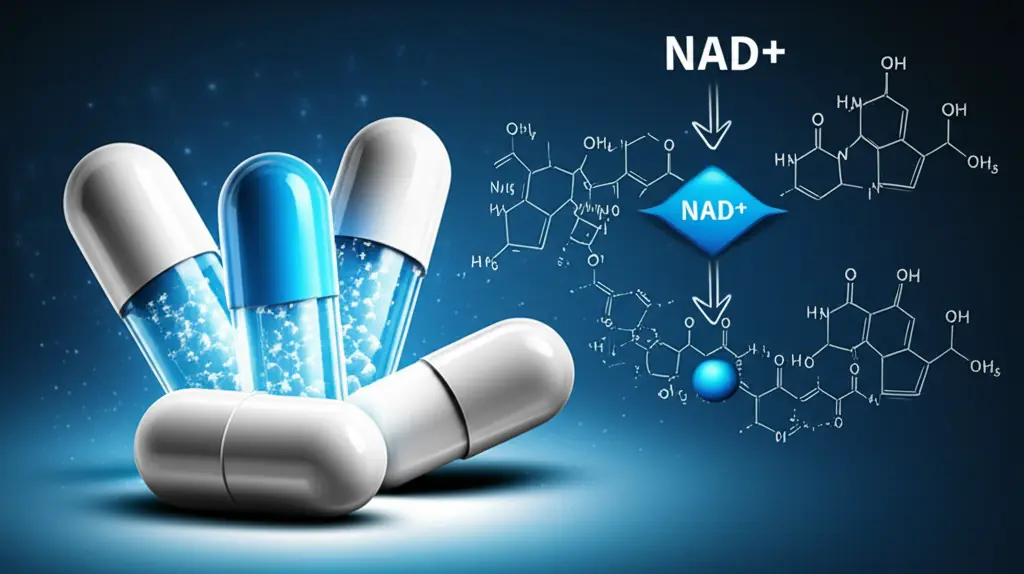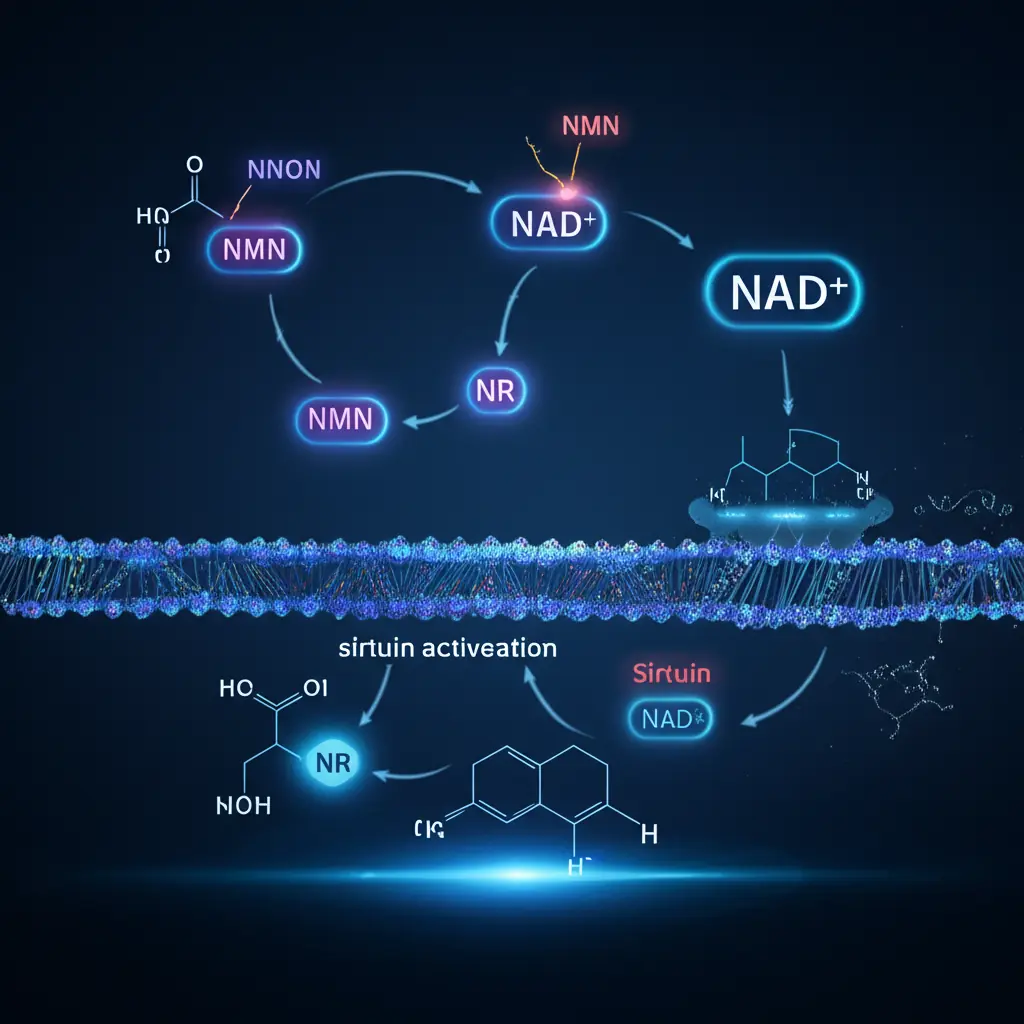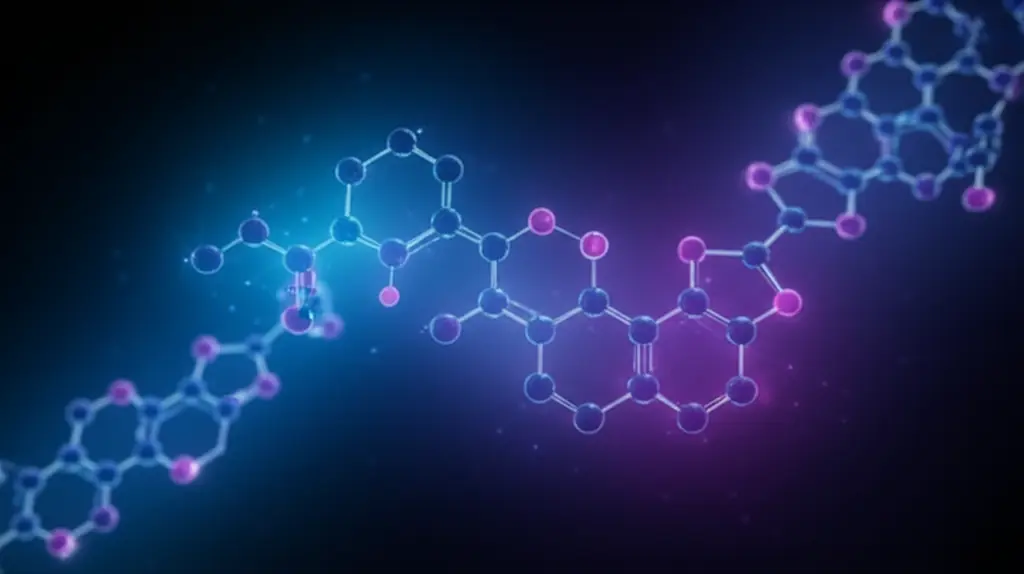NMN vs NAD+ vs NR: Which Longevity Supplement is Best?
Evidence-based comparison of NAD+ boosting supplements. Bioavailability, human trials, dosing protocols, and cost analysis to help you make an informed decision.


Quick Summary: Which Should You Choose?
NR has the most human clinical trials, FDA GRAS status, and proven NAD+ elevation (40-60% increase). Reliable brands, good cost-effectiveness at 300-500mg daily.
Recommended for beginnersNMN may have advantages in cellular uptake. Growing human evidence shows benefits for insulin sensitivity and aerobic capacity. Preferred by longevity researchers.
Advanced usersOral NAD+ shows minimal absorption. IV NAD+ provides acute benefits but expensive ($200-500/session) with unclear duration. Not cost-effective for most.
Not recommended orallyDetailed Supplement Analysis

$$$ Cost
Advantages
- Direct NAD+ precursor - bypasses some conversion steps
- Multiple human trials showing safety and efficacy
- May cross cell membranes via SLC12A8 transporter
- Shows benefits in insulin sensitivity, aerobic capacity
- Popular among longevity researchers (Sinclair protocol)
Disadvantages
- More expensive per dose than NR
- Long-term human data still accumulating
- Quality varies significantly between brands
- May require higher doses for some individuals
Evidence & Dosage
Human Evidence: Growing human trials, animal studies robust
Typical Dosage: 250-1000mg daily
Key Studies:
- • 10-week human trial: 250mg improved insulin sensitivity in prediabetic women
- • 12-week study: 300mg improved aerobic capacity by 6.5%
- • Safety established up to 1000mg daily for 12 weeks
$$-$$$ Cost
Advantages
- Most extensive human clinical trial data
- FDA GRAS (Generally Recognized as Safe) status
- Well-established safety profile
- Consistent NAD+ elevation in blood
- Multiple formulations available (Niagen, Tru Niagen)
Disadvantages
- Must convert to NMN before becoming NAD+ (extra step)
- Higher doses may cause flushing in some individuals
- Mixed results on tissue NAD+ levels
- Benefits may plateau at higher doses
Evidence & Dosage
Human Evidence: Most human clinical trials, FDA GRAS status
Typical Dosage: 300-1000mg daily
Key Studies:
- • 8-week RCT: 1000mg increased NAD+ by 60% in healthy adults
- • 6-week study: 500mg improved cardiovascular function in elderly
- • Multiple safety trials up to 2000mg daily
$$$$-$$$$$ Cost
Advantages
- IV administration shows immediate NAD+ increase
- Some subjective reports of enhanced energy (IV)
- No conversion steps required (in theory)
- Sublingual may bypass some degradation
Disadvantages
- Poor oral bioavailability - broken down in gut
- IV requires clinic visits, expensive ($200-500/session)
- No evidence oral NAD+ reaches tissues effectively
- Sublingual efficacy questionable, limited data
- Most expensive option per effective dose
Evidence & Dosage
Human Evidence: Limited oral efficacy, IV shows acute benefits
Typical Dosage: IV: 250-1000mg; Sublingual: varies
Key Studies:
- • Oral NAD+ shows minimal blood level increase
- • IV NAD+ increases blood levels acutely but duration unclear
- • No peer-reviewed trials on sublingual NAD+ efficacy
Head-to-Head Comparison
NR: Proven to increase NAD+ 40-60% in humans. NMN: Growing evidence of cellular uptake via SLC12A8 transporter. NAD+: Poor oral absorption.
NR has FDA GRAS status and most clinical trials. NMN has growing human data. Direct NAD+ oral has minimal efficacy data.
Animal studies show NMN effectively raises tissue NAD+. NR mixed results. Direct NAD+ oral unlikely to reach tissues.
NR provides best value at therapeutic doses. NMN more expensive. NAD+ IV extremely costly with unclear duration of benefits.
NR: FDA GRAS, extensive human trials up to 2000mg. NMN: Safe to 1000mg in trials. NAD+ IV: Generally safe but requires medical supervision.
Both available as oral supplements, easy daily dosing. NAD+ IV requires clinic visits.
Personalized Recommendations
NR (Nicotinamide Riboside)
Start with 300mg daily, increase to 500-1000mg if tolerated
Most clinical evidence, FDA GRAS status, established safety profile, cost-effective
NMN (Nicotinamide Mononucleotide)
250-1000mg daily, taken in morning
Potentially more direct pathway, growing human evidence, preferred by longevity researchers
NR at lower doses
300mg daily
Best value, proven efficacy at lower doses, reliable brands available
NMN + NR combination OR Cycling
NMN 250-500mg + NR 300mg OR alternate months
May provide synergistic effects through different pathways, anecdotal benefits from cycling
Safety Considerations & Important Notes
- • Third-party testing essential - look for COA (Certificate of Analysis)
- • NMN purity varies widely (50-99%) - affects efficacy and safety
- • Choose brands with GMP certification and independent testing
- • Storage matters: keep in cool, dark, dry place
- • Pregnant or breastfeeding women (insufficient safety data)
- • Individuals with cancer history (consult oncologist - NAD+ role in cancer unclear)
- • Those taking certain medications (potential interactions)
- • Anyone under 18 years old
NAD+ boosters work synergistically with lifestyle interventions:
- Exercise naturally boosts NAD+ levels - supplements may enhance this effect
- Caloric restriction/fasting activates SIRT1 (NAD+-dependent)
- Resveratrol works with NAD+ to activate sirtuins
The Bottom Line
Both NMN and NR effectively boost NAD+ levels with good safety profiles. The choice depends on your priorities:
- Choose NR if you prioritize: extensive human evidence, FDA GRAS status, cost-effectiveness, and established safety
- Choose NMN if you prioritize: potentially more direct pathway, growing research support, and following longevity researcher protocols
- Avoid oral NAD+ due to poor bioavailability - IV may have benefits but expensive with unclear duration
Remember: NAD+ boosting supplements are supplements, not replacements for proven longevity interventions. Prioritize exercise (40% mortality reduction with combined training), Mediterranean diet, sleep optimization (7-8 hours), and other evidence-based lifestyle factors first.